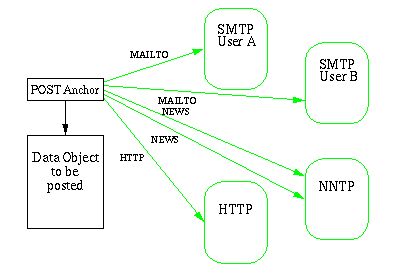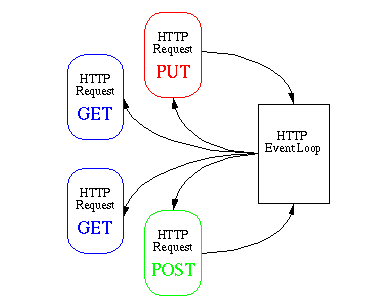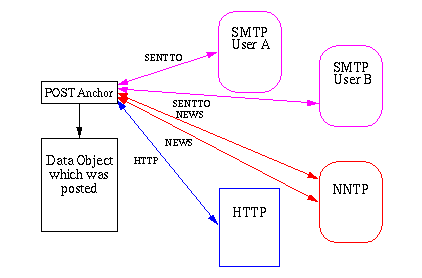 This document describes the posting interface between a World-Wide Web
client and the Library
of Common Code. The design has been made so that the interface is
flexible enough to support not only the POST
method in the HTTP
Protocol, but at the same time provide functionality for posting
to email addresses using SMTP and NNTP news groups. Posting
to other Internet servers such as FTP servers is not
considered in this document, but the concept is designed with the
possibility of including additional Internet protocols.
This document describes the posting interface between a World-Wide Web
client and the Library
of Common Code. The design has been made so that the interface is
flexible enough to support not only the POST
method in the HTTP
Protocol, but at the same time provide functionality for posting
to email addresses using SMTP and NNTP news groups. Posting
to other Internet servers such as FTP servers is not
considered in this document, but the concept is designed with the
possibility of including additional Internet protocols.
The document only describes the Client interface to the library but
not how the actual posting should take place using the HTTP protocol.
A draft specification is under development but has not been completed
at this point (August 1994).
Building a POST Web
The basic idea of the post interface to the library is that when using
POST, the user is often interested in posting the data object to more
than one recipient, e.g. the user can send the same data object to two
mailing lists, a news group and at the same time store the data object
as a file on a remote HTTP server. The term "data object" is used
instead of "document" because the object to be posted can be in any
MIME format and furthermore, it can be compressed or encoded before
transmission.

As indicated in the figure, the user builds a "POST Web" around an anchor element before the POST is committed and passed to the library. The rounded boxes are remote logical data objects that are still to be created and the lines are logical links between the post anchor and the remote data objects. The two links to the NNTP box represents that the data object is to be posted to two different news groups. In practice only one physical link would actually exist to the NNTP as all posting to a NNTP Server is done in one single transaction.
The actual user interface is for the client to implement, but typically a GUI-client could use drag-and-drop icons for building the Web. The POST Web could be visualized using a user implemented menu of icons of the most used recipients and then let the user drag lines between the data object to be posted and the recipients. The CERN library helps the user building the Web by providing the functionality of linking the anchors together.

However, PUT and POST methods are inherently different from the GET method as they require a data flow in both directions. This is especially the case using PUT as a data object often will be returned from the remote server.
The routine for handling the POST in the library parses the POST Web and groups the individual requests into protocol categories. In the case of a NNTP request, all POST requests are handled at the same time and send to the actual NNTP server. When the parsing of the Web is done, the post module recursively calls the protocol modules to execute the POST.
The posting mechanism is designed to be compatible with the multi-threaded structure of the library. This means that the client is asked for data based on an event driven action taken by the event loop. The client then gets a stream so that the document to be posted can be pumped down the stream and out on the net.

An immediate result from a post transaction is available using NNTP or HTTP but when using SMTP, the result might be delayed several days. In practice there is no way that the client can await a response for that amount of time. Therefore it is proposed to introduce "sentto" as a new URI scheme specifically to indicate the state of the posting to a mail address. This code means that the data object has been posted but no guarantee is given whether the recipient has actually received the data object or if the data object has been modified under the posting transaction. However, note that even on a successful return code from the server, the user is not guaranteed that the posting action has actually been executed or that the posted data object will not be changed or deleted. The returned URLs from the posting will therefore have the following syntax:
When all postings are terminated, a new anchor is generated containing the allocated links on the remote servers for future references (except in the SMTP case). The amount of links returned might be a subset of the requested recipients as only postings which terminated successfully are registered. Using this set, the client must determine what to do with failed postings. One possibility would be to try again using the failed part of the POST Web, or simply to discard it.
The "sentto" access scheme has been proposed as a new URI access scheme to compensate for the fact that when posting to a SMTP server, no guarantee is given that the data object has actually reached the recipient.
As mentioned in the introduction this document doesn't describe how the HTTP protocol should handle POST as this is all handled internally in the Library. However, the interface between the Library and the client stays the same regardless of the HTTP POST Implementation.
 Henrik
Frystyk, frystyk@info.cern.ch, July 1994
Henrik
Frystyk, frystyk@info.cern.ch, July 1994